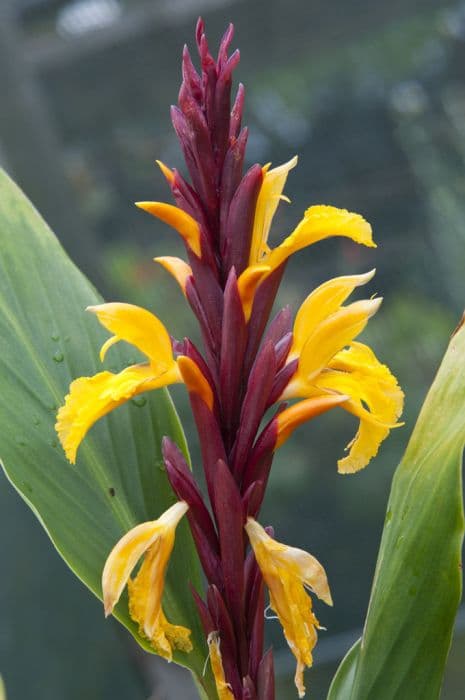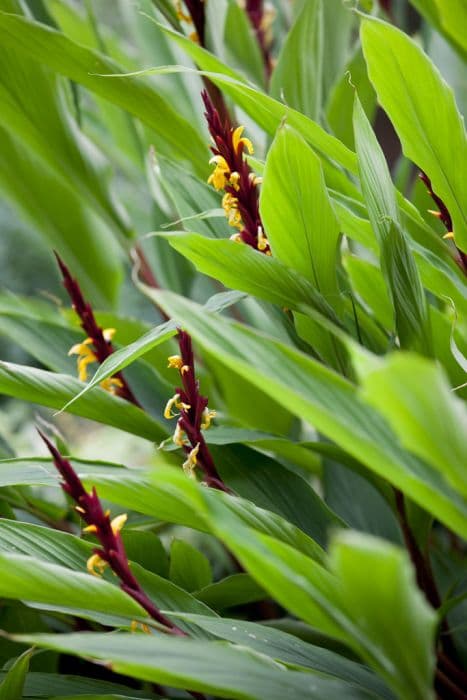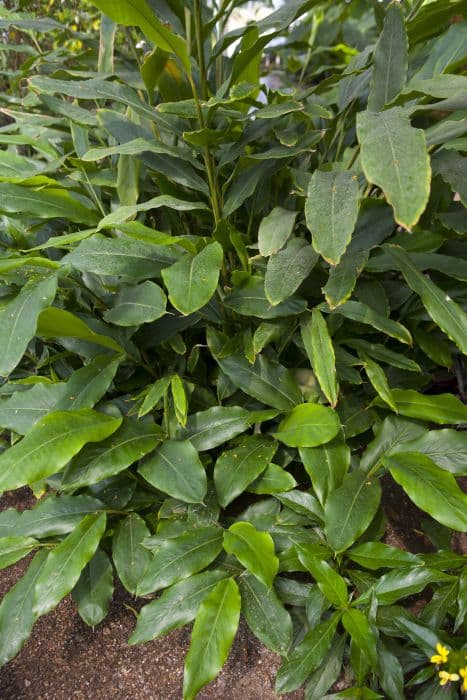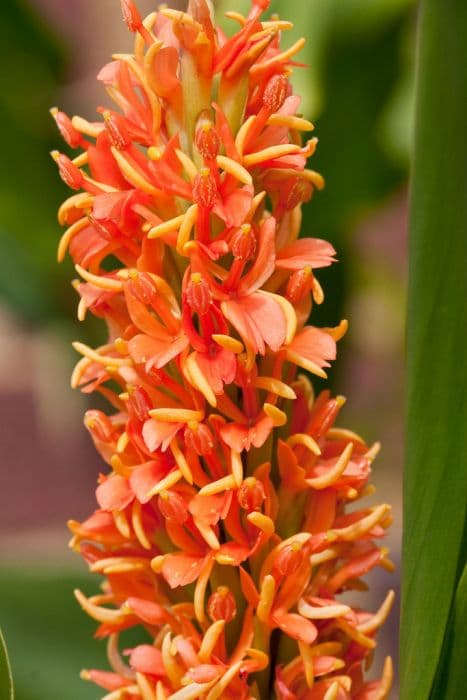Alpine Roscoea Roscoea alpina

ABOUT
The Roscoea alpina, commonly known as the Himalayan Ginger or Alpine Roscoea, is a perennial herbaceous plant notable for its vibrant features that add a dash of exotic beauty to gardens and natural landscapes. The plant sprouts from a fleshy rhizome that anchors it firmly in the soil. The leaves are an attractive deep green, long, and lance-shaped with a smooth texture, spiraling around the stem and providing a lush backdrop for the flowers. When in bloom, the Roscoea alpina exhibits striking orchid-like flowers that demand attention. The blossoms are usually a deep purple or lilac color, with a tube-like structure that flares out to form an intricate, delicate-looking flower. The flowers typically consist of two lips: the upper lip forms a hood over the lower lip, which often sports a distinctive yellow or white-marked throat, adding contrast and interest to the appearance. The flower stems rise from the center of the leafy clump, elevating the blooms to a position of prominence. The flowering period generally occurs during the summer months, inviting pollinators to visit. Following the flowering stage, the plant may produce capsules that contain seeds, thereby completing its life cycle and ensuring future generations of the Himalayan Ginger. Overall, the Roscoea alpina possesses an elegance that complements woodland settings, rock gardens, and borders well, imbuing them with a touch of the Himalayas' natural splendor.
About this plant
 Names
NamesFamily
Zingiberaceae.
Synonyms
Roscoea Alpina, Alpine Roscoea.
Common names
Roscoea alpina var. alba, Roscoea alpina var. schneideriana.
 Toxicity
ToxicityTo humans
Roscoea alpina, commonly referred to as Roscoea, does not have a well-documented profile of toxicity to humans in the scientific literature available up until now. There is no widespread evidence of significant toxic effects from ingesting this plant. However, as with many plants, individual reactions can vary and some people may experience mild discomfort, allergies or other adverse reactions. In absence of substantial data, it is generally advisable to avoid ingesting parts of unknown plants due to the potential risk of harmful effects.
To pets
Information on the toxicity of Roscoea alpina, or Roscoea, specifically toward pets like cats and dogs is not well-documented or widely recognized. This plant does not appear on major toxic plant lists for pets and there is a lack of reports regarding significant toxic effects following ingestion. However, the absence of data does not guarantee safety, and caution is still recommended. If a pet ingests parts of this plant, monitoring for any signs of gastrointestinal upset or abnormal behavior is advisable, and if such symptoms occur, consulting a veterinarian would be prudent.
 Characteristics
CharacteristicsLife cycle
Perennials
Foliage type
Deciduous
Color of leaves
Green
Flower color
Purple
Height
1 foot [30 cm]
Spread
1 foot [30 cm]
Plant type
Herb
Hardiness zones
6
Native area
Himalayas
Benefits
 General Benefits
General Benefits- Landscape Beautification: Roscoea alpina, commonly known as Alpine Roscoea, adds aesthetic value to gardens with its attractive purple flowers and lush foliage.
- Habitat for Wildlife: The flowers of Alpine Roscoea can attract pollinators like bees and butterflies, providing a food source and contributing to biodiversity.
- Soil Stabilization: The root system of Alpine Roscoea can help stabilize soil and prevent erosion on slopes or in alpine garden settings.
- Culinary Use: Some parts of Alpine Roscoea may be used as a spice or flavoring in certain regional cuisines, adding unique tastes to dishes.
- Cultural Significance: Alpine Roscoea may hold cultural value in certain regions, possibly used in traditional practices or ceremonies.
- Educational Interest: Gardeners and botany enthusiasts may find cultivating and studying Alpine Roscoea to be of educational merit, allowing them to learn more about alpine plants and their ecosystems.
 Medical Properties
Medical Properties- Anti-inflammatory: Roscoea alpina is believed to have anti-inflammatory effects and may be used in traditional medicine to reduce inflammation.
- Analgesic: There are indications that the plant may have pain-relieving properties.
- Antioxidant: The plant is thought to contain compounds with antioxidant activity, which can help in preventing cellular damage.
- Antimicrobial: Some studies suggest Roscoea alpina may possess antimicrobial properties against certain pathogens.
 Air-purifying Qualities
Air-purifying QualitiesThis plant is not specifically known for air purifying qualities.
 Other Uses
Other Uses- Roscoea alpina, commonly known as Roscoe's Lily, can be used as a natural dye source, its roots potentially yielding colors for textile applications.
- The plant's sturdy leaves can be utilized in creating eco-friendly packaging materials, providing a renewable option for wrapping perishable goods.
- Due to its ornamental nature, the flowers of Roscoe's Lily can be pressed and included in craft projects or homemade paper for decorative effects.
- Roscoea alpina can serve as an educational tool in botanic gardens and schools for studies on alpine flora and plant adaptations in mountainous habitats.
- The robust rhizomes can be carved or used in printmaking, as they can hold intricate details for stamping patterns on fabrics or paper.
- The plant can be incorporated into a wildlife-friendly garden, offering habitat and potential food sources for pollinators and insects native to its growing region.
- In culinary arts, although not commonly consumed, the flowers could be used as an exotic and edible garnish for special dishes, providing a mild flavor and aesthetic appeal.
- Roscoe's Lily can be planted for soil stabilization in hilly areas, as its roots may help prevent soil erosion and maintain terrain integrity.
- The seed pods of Roscoe's Lily can be dried and used as part of ornamental arrangements in dried flower bouquets or as table centerpieces.
- With their distinctive shape and color, the leaves and flowers of Roscoe's Lily can serve as inspiration for designers and artists in creating botanical illustrations, patterns, and motifs.
Interesting Facts
 Feng Shui
Feng ShuiRoscoea alpina is not used in Feng Shui practice.
 Zodiac Sign Compitability
Zodiac Sign CompitabilityRoscoea alpina is not used in astrology practice.
 Plant Symbolism
Plant Symbolism- Rarity: Roscoea alpina, commonly known as Alpine Roscoea, is a less common species compared to others in its genus, symbolizing uniqueness and the value of rare beauty.
- Resilience: Given its ability to thrive in alpine climates, the Alpine Roscoea can represent endurance and the ability to overcome challenging environments.
- Adaptability: As the plant can adapt to high altitudes and cold temperatures, it may symbolize flexibility and the capacity to adjust to varying conditions.
- Healing: Some species within the Roscoea genus are used in traditional medicine, and thus the Alpine Roscoea may be associated with healing and the soothing of ailments.
- Unique Beauty: Alpine Roscoea, with its distinctive floral structure, exemplifies the beauty that flourishes in unexpected places and can be seen as a symbol of finding beauty beyond common appearances.
 Water
WaterAlpine Roscoea requires consistent moisture during the growing season, which typically means watering the plant once a week, although this may vary depending on climate and weather conditions. It's essential to water deeply to reach the roots, equating to about 1 to 1.5 gallons per week for an established plant. Ensure the soil remains moist but not waterlogged, as excess water can lead to root rot. During its dormant period in the winter, reduce watering significantly, providing just enough to prevent the soil from drying out completely.
 Light
LightAlpine Roscoea thrives in partial shade where it can receive dappled sunlight. The best spot for this plant would be a location that gets morning sun and afternoon shade, or a place with filtered sunlight throughout the day. Direct afternoon sun can be too intense and may cause the foliage to burn, so ensure the plant is shielded during the hottest parts of the day.
 Temperature
TemperatureAlpine Roscoea does well in a temperature range from 50°F to 75°F, which are ideal conditions for this plant. It can survive minimum temperatures down to about 20°F, but growth will be best if temperatures are kept above freezing. During active growth in the warmer months, make sure the plant is not exposed to extreme heat above 85°F for prolonged periods.
 Pruning
PruningPruning Alpine Roscoea is primarily for removing spent flowers and any dead or yellowing foliage to encourage healthy growth and maintain a tidy appearance. This should be done after the blooming period, typically in late summer or early fall. Minimal pruning is required; only cut back the parts of the plant that are no longer thriving. This may also encourage a second flush of flowers in some cases.
 Cleaning
CleaningAs needed
 Soil
SoilRoscoea alpina, commonly known as Himalayan ginger, thrives best in a soil mix that is rich, well-draining, and has a high content of organic matter. It should have a pH of around 6.5 to 7.5. A mix of loam, peat, and sand in equal parts with some added leaf mold or compost is ideal.
 Repotting
RepottingHimalayan ginger should be repotted every 2 to 3 years or when it outgrows its current container. It is best to repot in the spring just before the growing season begins.
 Humidity & Misting
Humidity & MistingHimalayan ginger prefers moderate humidity levels. It does well in average home humidity but benefits from increased humidity, especially during the active growing season. A range of 40-60% is often suitable.
 Suitable locations
Suitable locationsIndoor
Keep Himalayan ginger in bright, indirect light with moist soil indoors.
Outdoor
Plant Himalayan ginger in part shade, protect from strong winds, water regularly.
Hardiness zone
6-9 USDA
 Life cycle
Life cycleRoscoea alpina, commonly known as Alpine Roscoea, begins its life cycle as a seed, typically germinating in cool, moist soil conditions often found in its native Himalayan habitat. After germination, the seedling grows into a rosette of leaves at ground level, a phase during which energy is accumulated and stored in an underground rhizome. This perennial herb emerges each spring with new leaf growth, followed by the development of a flowering stem, if the plant has reached sufficient maturity and environmental conditions are favorable. Blooming occurs in the summer, with the plant producing distinctive purple or violet flowers that attract pollinators for sexual reproduction. Once pollinated, the flowers give way to seed capsules that eventually dry and release seeds for the next generation. The above-ground parts of the plant die back in winter, leaving the rhizome dormant underground until the next growing season.
 Propogation
PropogationPropogation time
Spring-Summer
The most popular method of propagation for Roscoea alpina, commonly known as Himalayan ginger or Alpine ginger, is by division of the rhizomes. This should ideally be done in the spring, just as new growth begins. Gardeners should carefully dig up the mature plants, ensuring they keep a good amount of soil around the roots to avoid damage. The rhizomes should be cut apart with a clean, sharp knife, making sure that each section has at least one growth bud. These divisions can then be planted in a prepared area with well-draining soil, at a depth of about 2 to 3 inches (5 to 7.5 cm), and spaced approximately 12 inches (approximately 30 cm) apart. Regular watering and a little patience will allow these divisions to establish themselves and grow into new plants.









